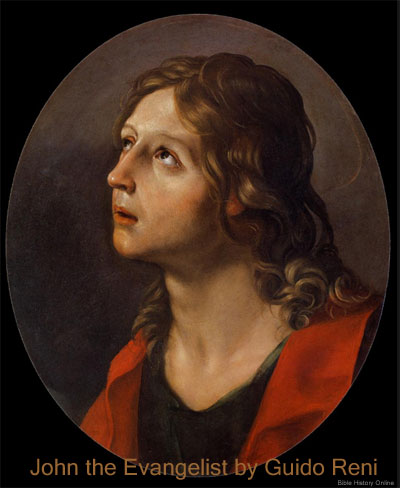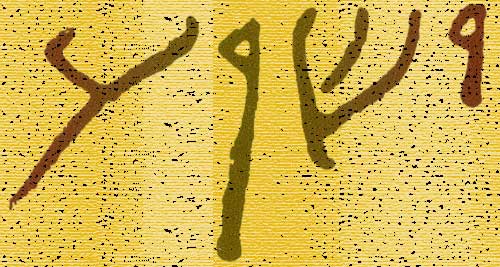3. I will give power--There is no "power" in the
Greek, so that "give" must mean "give commission," or
some such word.
my two witnesses--Greek, "the two witnesses of
me." The article implies that the two were well known at least to John.
prophesy--preach under the inspiration of the Spirit, denouncing
judgments against the apostate. They are described by symbol as "the
two olive trees" and "the two candlesticks," or lamp-stands,
"standing before the God of the earth." The reference is to
Zec 4:3, 12,
where two individuals are meant, Joshua and Zerubbabel, who
ministered to the Jewish Church, just as the two olive trees emptied
the oil out of themselves into the bowl of the candlestick. So in the
final apostasy God will raise up two inspired witnesses to minister
encouragement to the afflicted, though sealed, remnant. As two
candlesticks are mentioned in
Re 11:4,
but only one in
Zec 4:2,
I think the twofold Church, Jewish and Gentile, may be meant by the two
candlesticks represented by the two witnesses: just as in
Re 7:1-8
there are described first the sealed of Israel, then those of all
nations. But see on
Re 11:4.
The actions of the two witnesses are just those of Moses when
witnessing for God against Pharaoh (the type of Antichrist, the last
and greatest foe of Israel), turning the waters into blood, and
smiting with plagues; and of Elijah (the witness for God
in an almost universal apostasy of Israel, a remnant of seven thousand,
however, being left, as the 144,000 sealed,
Re 7:1-8)
causing fire by his word to devour the enemy, and
shutting heaven, so that it rained not for three years and six
months, the very time (1260 days) during which the two witnesses
prophesy. Moreover, the words "witness" and "prophesy" are usually
applied to individuals, not to abstractions (compare
Ps 52:8).
DE BURGH thinks Elijah and
Moses will again appear, as
Mal 4:5, 6
seems to imply (compare
Mt 17:11;
Ac 3:21).
Moses and Elijah appeared with Christ at the Transfiguration, which
foreshadowed His coming millennial kingdom. As to Moses, compare
De 34:5, 6;
Jude 9.
Elias' genius and mode of procedure bears the same relation to the
"second" coming of Christ, that John the Baptist's did to the first
coming [BENGEL]. Many of the early Church thought
the two witnesses to be Enoch and Elijah. This would avoid the
difficulty of the dying a second time, for these have never yet
died; but, perhaps, shall be the witnesses slain. Still, the turning
the water to blood, and the plagues
(Re 11:6),
apply best to "Moses (compare
Re 15:3,
the song of Moses"). The transfiguration glory of Moses and
Elias was not their permanent resurrection-state, which shall not be
till Christ shall come to glorify His saints, for He has precedence
before all in rising. An objection to this interpretation is that those
blessed departed servants of God would have to submit to death
(Re 11:7, 8),
and this in Moses' case a second time, which
Heb 9:27
denies. See on
Zec 4:11, 12,
on the two witnesses as answering to "the two olive trees." The two
olive trees are channels of the oil feeding the Church, and symbols of
peace. The Holy Spirit is the oil in them. Christ's witnesses, in
remarkable times of the Church's history, have generally appeared in
pairs: as Moses and Aaron, the inspired civil and religious
authorities; Caleb and Joshua; Ezekiel the priest and Daniel the
prophet; Zerubbabel and Joshua.
in sackcloth--the garment of prophets, especially when calling
people to mortification of their sins, and to repentance. Their very
exterior aspect accorded with their teachings: so Elijah, and John who
came in His spirit and power. The sackcloth of the witnesses is
a catch word linking this episode under the sixth trumpet, with the
sun black as sackcloth (in righteous retribution on the
apostates who rejected God's witnesses) under the sixth seal
(Re 6:12).
JFB.
The Book of Revelation
Revelation 1:9-11 - I John, who also am your brother, and companion in tribulation, and in the kingdom and patience of Jesus Christ, was in the isle that is called Patmos, for the word of God, and for the testimony of Jesus Christ. I was in the Spirit on the Lord's day, and heard behind me a great voice, as of a trumpet, Saying, I am Alpha and Omega, the first and the last: and, What thou seest, write in a book, and send [it] unto the seven churches which are in Asia; unto Ephesus, and unto Smyrna, and unto Pergamos, and unto Thyatira, and unto Sardis, and unto Philadelphia, and unto Laodicea.
Revelation 19:11-16 - And I saw heaven opened, and behold a white horse; and he that sat upon him [was] called Faithful and True, and in righteousness he doth judge and make war. His eyes [were] as a flame of fire, and on his head [were] many crowns; and he had a name written, that no man knew, but he himself. And he [was] clothed with a vesture dipped in blood: and his name is called The Word of God. And the armies [which were] in heaven followed him upon white horses, clothed in fine linen, white and clean. And out of his mouth goeth a sharp sword, that with it he should smite the nations: and he shall rule them with a rod of iron: and he treadeth the winepress of the fierceness and wrath of Almighty God. And he hath on [his] vesture and on his thigh a name written, KING OF KINGS, AND LORD OF LORDS.
Revelation 22:18-20 For I testify unto every man that heareth the words of the prophecy of this book, If any man shall add unto these things, God shall add unto him the plagues that are written in this book: And if any man shall take away from the words of the book of this prophecy, God shall take away his part out of the book of life, and out of the holy city, and [from] the things which are written in this book. He which testifieth these things saith, Surely I come quickly. Amen. Even so, come, Lord Jesus.
Revelation in The New Testament - A Brief Overview

Painting of St. John the Evangelist by Reni - 1620
Introduction to The Book of Revelation
Brief Summary. John describes the seven churches in Asia, he records the visions that he received, and in the prophecy Jesus returns as the kinsman redeemer to claim this world as His inheritance. The final battle unfolds in a 7 year period through a series of seal, trumpet, and bowl judgements, He casts the antichrist and false prophet into the lake of fire and sets up the New Jerusalem, the new heaven and new earth for the redeemed. The book of Revelation is in harmony with the prophecies in the Old Testament especially the ones written by Ezekiel, Daniel and Zechariah.
Summary of The Book of Revelation
Author. John the apostle names himself as the one who wrote down what the Lord said through the angel. The earliest writers in the church like Justin Martyr, Irenaeus, Hippolytus, Tertullian, Clement of Alexandria and the Muritorian all credit John the apostle as author of the book of Revelation.
Date. John indicates that he was on the Island of Patmos when he received the prophecy (Revelation 1:9). According to tradition John wrote during the reign of the Emperor Domitian which would have been around 95 AD. Tradition also states that John was released the next year and was allowed to return to Ephesus. Domitian was perhaps the cruelest Emperor toward the Christians, demanding that he was to worshipped as deity, or be put to death.
Audience. John said that the prophecy was directed to the seven churches in Asia (Revelation 1:4).
Outline of the Book of Revelation
Description and Fate of False Teachers - 1:1-16
Encouragement to Believers in Christ - 1:17-25

The Name Jesus In Ancient Hebrew Text
"Yeshua" in First Century Hebrew Text. This is how the name "Jesus"
would have been written in ancient Hebrew documents. The four letters or
consonants from right to left are Yod, Shin, Vav, Ayin (Y, SH, OO, A).
Jesus is the Greek name for the Hebrew name Joshua or Y'shua which means
"The LORD or Yahweh is Salvation".
The Book of Revelation Resources
Map of the Roman Empire (14 A.D.) - This map reveals the Roman Empire during the time shortly after the birth of Jesus, in 14 AD at the time of the death of Augustus. The order which prevailed in this extensive empire, the good military roads, and the use of Koine Greek as the general language of culture throughout the area were among the factors which multiplied the rapid spread of the Gospel of Jesus Christ. (Color Map)
Map of Paul's First Missionary Journey (48 A.D.) - This map reveals the areas in Asia Minor where Paul visited in his first missionary journey. Around 48 AD, in the springtime, Paul and his companions Barnabas and Mark were sent on a mission from the church in Antioch. This would be the first of Paul's Missionary Journey's. (Color Map)
Map of Paul's Second Missionary Journey (51 A.D.) - This map reveals the areas in Asia and Greece where Paul visited in his second missionary journey. Paul re-visits a couple cities in Asia, one of which was Lystra where he was stoned and left for dead a few years earlier. He later has a vision that leads him over to Greece and Paul and his companions travel and minister in various cities in Greece (Philippi, Thessalonica, Berea, Athens and Corinth. Later Paul returns to Ephesus and finally to Caesarea and Antioch. (Color Map)
Map of Paul's Third Missionary Journey (54 A.D.) - This map reveals the areas in Asia and Greece where Paul visited in his third missionary journey. On Paul's third missionary journey he returned to the cities he had first visited on his first missionary journey. During this time he decided to remain in Ephesus for about 3 years, and this city was the main focus of his activities and an important Christian community (Acts 19). (Color Map)
Map of the New Testament World - This map reveals the "Nations" within the ancient world during the first century A.D., the time of the New Testament. The map includes the areas of Israel, Asia, Greece, and Italy. (Color Map)
Map of New Testament Greece This map reveals the cities within Greece in the ancient world during the first century A.D.,The map includes the principal cities of Greece like: Athens, Corinth, and Thessalonica, and provinces like Macedonia and Achaia. (Color Map)
Map of New Testament Asia - This map shows the cities within
Asia Minor during the first century A.D., the time of the New
Testament. The map includes the principal cities of Asia
including Tarsus, Ephesus, and Colossae, and provinces like
Galatia and Pamphilia. (Color Map)